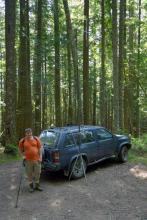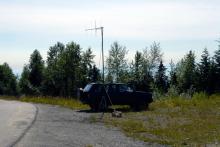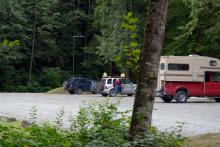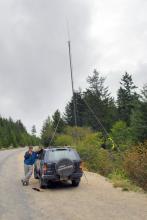Eric Tries Cross-Banding
Eric Tries Cross-Banding
I have been traveling the back country for years, exploring the logging roads and hiking the hills. It was my desire for safety that led me to radio. My first radio was a commercial unit that enabled me to track the logging trucks on the narrow roads and communicate with them as needed. This sparked my interest in radio as a hobby and I obtained my license and many more radios.
As I am doing a lot of hiking, I am no longer with my vehicle and the powerful mobile radio and large antennas that go with it. This has concerned me as I still want to have good radio contact to ensure quick access for safety related problems. The typical handheld may be great for local communications but it often cannot get into a repeater except near the top of various mountains. I decided to try a cross-band repeater to see if this would provide adequate coverage while deep in the bush with only my handheld.
My initial purchase was a mast that comprised short segments that could be easily assembled in the field. Next I purchased a Yaesu FT-8800 mobile radio to do the repeater function. I already had a 2m Yagi, battery and coax so I was ready to try it out. Though the Yagi was only designed for 2m, it seemed to work for 440 and so I was willing to try it out.
My first task was to try setting up the 10 segment mast. Ethan and I worked in the back yard to put it up, we succeeded several times in putting it up the full height and taking it down though on one occasion it was a tree that saved the Yagi from being damaged. We decided that using the full height of 37 feet was probably not necessary and we would normally use fewer segments for most deployments.
Our first trip with the set up was to Ford Mountain on July 26, 2008. We set up the equipment deep in the trees and pointed the Yagi at Sumas Mountain. We had no trouble getting into the 661 repeater and though we had to fiddle with the power cord to get power to the radio we were soon on our way to the peak. The handhelds were able to work the Yaesu the entire hike. This was an easy first test as we were no further than a kilometer away.
Our second trip was to Cypress Bowl and Hollyburn Peak. I had serious signal level trouble with the setup this morning and with the rapidly increasing temperature I was getting very frustrated. The Yagi was only able to make weak contact with the White Rock repeater – the whip on the truck was doing better. During the hike I had serious trouble getting into the Yaesu. I concluded that the setup was not working well. Later it was determined that the longer coax had a bad end and I had to replace it.
Our third trip was to Golden Ears Park and the lower falls on the Gold River. The radio got into the 661 repeater with no problem and the hand held was able to work the repeater at the furthest point in our hike but it was weak and spotty – not at all what I was hoping for. So I decided that I needed a true dual band Omni-directional antenna so that I could get better UHF signal strength. I bought the Comet GP-3 co-linear as it was fairly portable and easy to set up. It provided 4.5dB gain on VHF and 7.2 on 440. Though not as strong as the yagi for reaching a repeater it gave good gain for the handhelds. I also upgraded the antennas on the handhelds as well.
So my next hike was to Lindeman and Greendrop lakes. Here I would be a 1000 feet above the repeater and 5.5km up a curving valley deep in bush. Ethan also had just received his ham license so that added to the fun. We setup the mast with the new vertical antenna using 6 segments. Contact to the 661 repeater was solid at the higher medium power (20 watts) and so off we went. The handhelds were able to work the repeater the entire hike. This was quite amazing and though great, it exceeded my expectations. The new antennas were working very well.
I will try this in a few more settings and then try using both the Yagi for reaching the repeater and the vertical for the handhelds, giving maximum gain for both sides of the equation.




